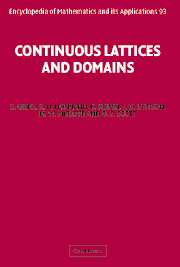Book contents
- Frontmatter
- Contents
- Preface
- Acknowledgments
- Foreword to A Compendium of Continuous Lattices
- Introduction to A Compendium of Continuous Lattices
- O A Primer on Ordered Sets and Lattices
- I Order Theory of Domains
- II The Scott Topology
- III The Lawson Topology
- IV Morphisms and Functors
- V Spectral Theory of Continuous Lattices
- VI Compact Posets and Semilattices
- VII Topological Algebra and Lattice Theory: Applications
- Bibliography
- List of Symbols
- List of Categories
- Index
Preface
Published online by Cambridge University Press: 13 August 2009
- Frontmatter
- Contents
- Preface
- Acknowledgments
- Foreword to A Compendium of Continuous Lattices
- Introduction to A Compendium of Continuous Lattices
- O A Primer on Ordered Sets and Lattices
- I Order Theory of Domains
- II The Scott Topology
- III The Lawson Topology
- IV Morphisms and Functors
- V Spectral Theory of Continuous Lattices
- VI Compact Posets and Semilattices
- VII Topological Algebra and Lattice Theory: Applications
- Bibliography
- List of Symbols
- List of Categories
- Index
Summary
BACKGROUND. In 1980 we published A Compendium of Continuous Lattices. A continuous lattice is a partially ordered set characterized by two conditions: firstly, completeness, which says that every subset has a least upper bound; secondly, continuity, which says that every element can be approximated from below by other elements which in a suitable sense are much smaller, as for example finite subsets are small in a set theoretical universe. A certain degree of technicality cannot be avoided if one wants to make more precise what this “suitable sense” is: we shall do this soon enough. When that book appeared, research on continuous lattices had reached a plateau.
The set of axioms proved itself to be very reasonable from many viewpoints; at all of these aspects we looked carefully. The theory of continuous lattices and its consequences were extremely satisfying for order theory, algebra, topology, topological algebra, and analysis. In all of these fields, applications of continuous lattices were highly successful. Continuous lattices provided truly interdisciplinary tools.
Major areas of application were the theory of computing and computability, as well as the semantics of programming languages. Indeed, the order theoretical foundations of computer science had been, some ten years earlier, the main motivation for the creation of the unifying theory of continuous lattices. Already the Compendium of Continuous Lattices itself contained signals pointing future research toward more general structures than continuous lattices.
- Type
- Chapter
- Information
- Continuous Lattices and Domains , pp. xi - xxPublisher: Cambridge University PressPrint publication year: 2003



